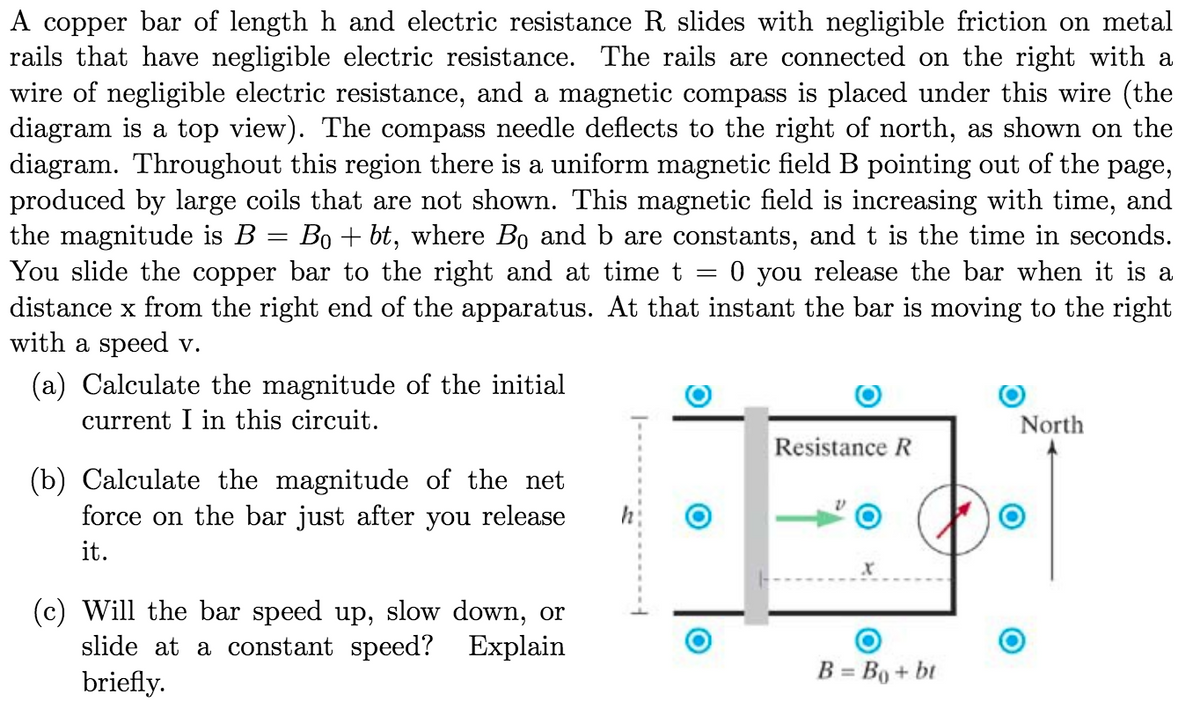A copper bar of length h and electric resistance R slides with negligible friction on metal rails that have negligible electric resistance. The rails are connected on the right with a wire of negligible electric resistance, and a magnetic compass is placed under this wire (the diagram is a top view). The compass needle deflects to the right of north, as shown on the diagram. Throughout this region there is a uniform magnetic field B pointing out of the page, produced by large coils that are not shown. This magnetic field is increasing with time, and the magnitude is B = Bo + bt, where Bo and b are constants, and t is the time in seconds. You slide the copper bar to the right and at timet = 0 you release the bar when it is a distance x from the right end of the apparatus. At that instant the bar is moving to the right with a speed v. (a) Calculate the magnitude of the initial current I in this circuit. North Resistance R (b) Calculate the magnitude of the net force on the bar just after you release it. (c) Will the bar speed up, slow down, or slide at a constant speed? Explain briefly. B = Bo + bt
A copper bar of length h and electric resistance R slides with negligible friction on metal rails that have negligible electric resistance. The rails are connected on the right with a wire of negligible electric resistance, and a magnetic compass is placed under this wire (the diagram is a top view). The compass needle deflects to the right of north, as shown on the diagram. Throughout this region there is a uniform magnetic field B pointing out of the page, produced by large coils that are not shown. This magnetic field is increasing with time, and the magnitude is B = Bo + bt, where Bo and b are constants, and t is the time in seconds. You slide the copper bar to the right and at timet = 0 you release the bar when it is a distance x from the right end of the apparatus. At that instant the bar is moving to the right with a speed v. (a) Calculate the magnitude of the initial current I in this circuit. North Resistance R (b) Calculate the magnitude of the net force on the bar just after you release it. (c) Will the bar speed up, slow down, or slide at a constant speed? Explain briefly. B = Bo + bt
Principles of Physics: A Calculus-Based Text
5th Edition
ISBN:9781133104261
Author:Raymond A. Serway, John W. Jewett
Publisher:Raymond A. Serway, John W. Jewett
Chapter22: Magnetic Forces And Magnetic Fields
Section: Chapter Questions
Problem 51P
Related questions
Question
can you help with sub questions a, b, and c
this is not and will not be graded

Transcribed Image Text:A copper bar of length h and electric resistance R slides with negligible friction on metal
rails that have negligible electric resistance. The rails are connected on the right with a
wire of negligible electric resistance, and a magnetic compass is placed under this wire (the
diagram is a top view). The compass needle deflects to the right of north, as shown on the
diagram. Throughout this region there is a uniform magnetic field B pointing out of the page,
produced by large coils that are not shown. This magnetic field is increasing with time, and
the magnitude is B = Bo + bt, where Bo and b are constants, and t is the time in seconds.
You slide the copper bar to the right and at time t
distance x from the right end of the apparatus. At that instant the bar is moving to the right
with a speed v.
0 you release the bar when it is a
(a) Calculate the magnitude of the initial
current I in this circuit.
North
Resistance R
(b) Calculate the magnitude of the net
force on the bar just after you release
it.
(c) Will the bar speed up, slow down, or
slide at a constant speed? Explain
briefly.
B = Bo + bt
Expert Solution
This question has been solved!
Explore an expertly crafted, step-by-step solution for a thorough understanding of key concepts.
This is a popular solution!
Trending now
This is a popular solution!
Step by step
Solved in 5 steps

Knowledge Booster
Learn more about
Need a deep-dive on the concept behind this application? Look no further. Learn more about this topic, physics and related others by exploring similar questions and additional content below.Recommended textbooks for you

Principles of Physics: A Calculus-Based Text
Physics
ISBN:
9781133104261
Author:
Raymond A. Serway, John W. Jewett
Publisher:
Cengage Learning


Physics for Scientists and Engineers: Foundations…
Physics
ISBN:
9781133939146
Author:
Katz, Debora M.
Publisher:
Cengage Learning

Principles of Physics: A Calculus-Based Text
Physics
ISBN:
9781133104261
Author:
Raymond A. Serway, John W. Jewett
Publisher:
Cengage Learning


Physics for Scientists and Engineers: Foundations…
Physics
ISBN:
9781133939146
Author:
Katz, Debora M.
Publisher:
Cengage Learning

Physics for Scientists and Engineers with Modern …
Physics
ISBN:
9781337553292
Author:
Raymond A. Serway, John W. Jewett
Publisher:
Cengage Learning

Glencoe Physics: Principles and Problems, Student…
Physics
ISBN:
9780078807213
Author:
Paul W. Zitzewitz
Publisher:
Glencoe/McGraw-Hill